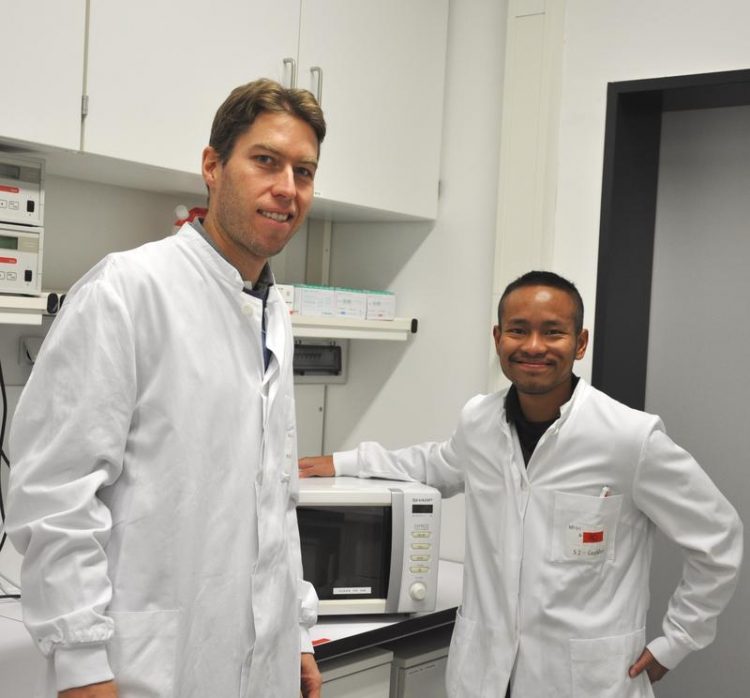Hepatitis C and HIV prophylaxis: microwave reduces viral transmission in the drugs scene

PD Dr. Eike Steinmann und Anindya Siddharta TWINCORE/Romy Weller
“The initial idea for this project came during a telephone call with Pedro Mateu-Gelabert, a New York based street worker with whom we have worked with for a long time already”, recalls Eike Steinmann, head of the Research Group Virus Transmission at the Institute for Experimental Virology. “He asked me, whether it is possible to treat the potential contaminated drug equipment with microwave irradiation to inactivate HCV and HIV. Everybody in the USA has a microwave oven…”
The project idea was born, the microwave oven was quickly bought in an electronics shop and brought to the laboratory. A simple and safe method to inactivate these viruses is important for two reasons: First of all, the risk of blood-borne viral transmission is extremely high within the drug injection community through sharing of drug paraphernalia. On the other hand, the available regimens for the treatment of HCV infection are very expensive and most of the time, an infected drug addict has limited access to the medication. Moreover, those treatments do not protect against re-infection.
The principle of microwave irradiation is based on the excitation of water that results in heating of the whole sample. “Since we knew from the previous study that HCV is temperature-sensitive, the microwave approach was very promising”, says Anindya Siddharta, scientist in the research group. Indeed, two minutes of irradiation at 360 watt is sufficient to inactivate HCV particles in solution.
In cooperation with the research group Innate Immunity and Viral Evasion, TWINCORE, they extended the experiments to HIV, as one out of three people who are infected with HIV are also HCV positive. This approach resulted in the same findings. Higher power levels and lower irradiation time, however, could not inactivate the viruses. “Less than two minutes is not sufficient reach the critical inactivation temperature.”
Aside from virus containing supernatants, the TWINCORE-scientist also tested this method in the presence of street heroin to assess whether heroin plays a role in the virus infectivity. “A further important point for the daily application of microwave oven in the drug injection community is the treatment of drug preparation equipment”, highlights Eike Steinmann.
In addition to syringes and spoons, these include small cigarette filters, which are used to draw the heroin preparation into the syringe. This trick avoids clogging of the needle with any impurities. These filters – since they still contain residual heroin – are often reused and shared. Thus, these filters bear the greatest risk of infection, but, “both filters and syringes, are no longer infectious after three minutes at 360 watts in the microwave, even if they are dried for 24 hours”, say Eike Steinmann.
“The only limitation is the metal needles of the syringe, which of course should not be heated in the microwave oven. They should be disinfected using other methods.” The irradiation of the filter takes a little bit longer so that the heat could be distributed to the entire filter. After three minutes of irradiation, filters and syringes are free from infectious viruses and the risk of infection with HCV or HIV can be prevented in this way.
Publication:
Siddhartha et al., Inactivation of HCV and HIV by microwave: a novel approach for prevention of virus transmission among people who inject drugs (2016);6:36619.doi:10.1038/srep36619
TWINCORE, Centre for Experimental and Clinical Infection Research is a joint venture between the Helmholtz-Centre for Infection Research in Braunschweig and the Hannover Medical School.
Media Contact
All latest news from the category: Life Sciences and Chemistry
Articles and reports from the Life Sciences and chemistry area deal with applied and basic research into modern biology, chemistry and human medicine.
Valuable information can be found on a range of life sciences fields including bacteriology, biochemistry, bionics, bioinformatics, biophysics, biotechnology, genetics, geobotany, human biology, marine biology, microbiology, molecular biology, cellular biology, zoology, bioinorganic chemistry, microchemistry and environmental chemistry.
Newest articles

Security vulnerability in browser interface
… allows computer access via graphics card. Researchers at Graz University of Technology were successful with three different side-channel attacks on graphics cards via the WebGPU browser interface. The attacks…

A closer look at mechanochemistry
Ferdi Schüth and his team at the Max Planck Institut für Kohlenforschung in Mülheim/Germany have been studying the phenomena of mechanochemistry for several years. But what actually happens at the…

Severe Vulnerabilities Discovered in Software to Protect Internet Routing
A research team from the National Research Center for Applied Cybersecurity ATHENE led by Prof. Dr. Haya Schulmann has uncovered 18 vulnerabilities in crucial software components of Resource Public Key…





















